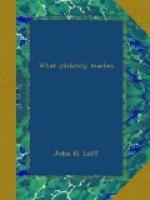When a plate is to be printed from, it is first warmed, then the ink is applied and rubbed into the lines with a pad. The surface of the plate is wiped off with a cloth, then with the hand and lastly, polished with whiting. A sheet of dampened paper is next laid on the plate and the whole is passed under the roller of a press, which forces the paper into the lines of the plate, where it takes up the ink. When the plate is deeply engraved the ink seems to stand up from the surface of the paper in ridges and some times we find corresponding depressions on the backs of the stamps. The sheets are then dried, gummed and dried again. They are now so much curled and wrinkled that they are placed between sheets of bristol board and subjected to hydraulic pressure of several hundred tons which effectively straightens them out.
The second process of printing from metallic plates is called typography. The plates for this process are the exact reverse of those engraved in taille douce. Instead of the design being cut into the plate, it is on the surface and everything else is cut away. Hence, the term “surface printing.” This form of engraving is also called epargne engraving, because the parts of the plate which bear the design are epargne (preserved.)
The dies for typographical plates are cut in wood or steel, usually the former. They are reproduced by two methods, stereotyping and electrotyping. In the former process casts of the die are taken in papier mache or plaster of Paris. From these casts other casts are taken in type-metal. A sufficient number of these casts are clamped together or fastened to a backing of wood and thus form a plate. This process is not much used for stamps. It may interest you to know that most of our large newspapers employ this process. The type-set forms are, of course, flat. From them papier mache impressions are taken and bent into a curve, so that the casts made from them will fit the cylinders of the printing presses.
In electrotyping, an impression is taken from the die in wax or gutta percha. The surface of this impression is coated with powdered plumbago. It is placed in a solution of sulphate of copper and, by the action of a galvanic battery, a thin shell of copper is deposited on it. This shell is backed with type-metal and is then ready for use. A number of these elecrotypes may be fastened together and electrotyped in one piece.
There is also a photographic process for making typographical dies. This is said to be used in making the stamps of France and her colonies.
[Illustration: Cliche with two stamps, “Colombia”, 5 cents]
[Illustration: Cliche with two stamps, “Colonies de l’Empire Francais”, 10 c.]
Stereotypes or electrotypes of single stamps are called cliches. In making up a plate it sometimes happens that a cliche is placed upside down. The result, after printing, is a stamp in that position. This is called a tete beche. We illustrate here such a stamp and another which is semi tete beche, i.e., turned half around instead of being entirely inverted. Like all oddities these are prized by stamp collectors.




